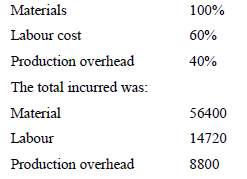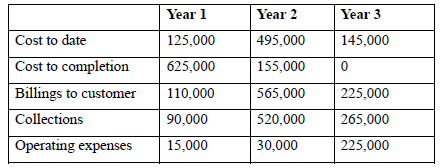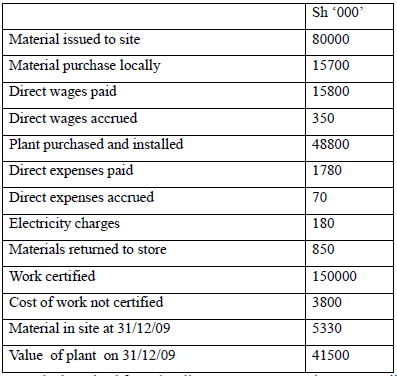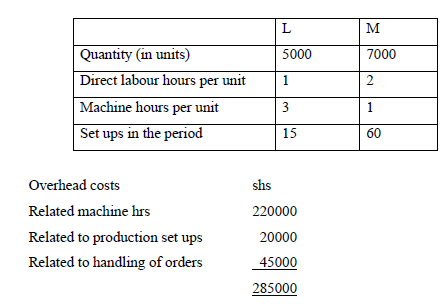
- This is the difference between the standard direct labour cost and the actual direct labour cost incurred for the production achieved. This is the sum of labour rate variance and labour efficiency variance.
(a) Labour Rate Variance
This is the difference between the standard and actual direct labour hour rate per hour for the total hours worked. It is calculated as under:
(Actual rate x Actual hours) – Standard rate x Actual hours
- The main causes of these variances are:-
i) Higher or lower rate paid t the workers as compared to standard rate.
ii) Different grades of labourers used than planned.
iii) Payment of bonus or overtime to the workers not anticipated in advance.
(b) Labour Efficiency Variance
- This is the difference between the standard hours for the actual production achieved and the hours actually worked, valued at the standard labour rate. It is calculated as under:-
Standard labour rate (actual hours – standard hours)
- The variance arises due to the following reasons:-
i) Lower or higher efficiency of workers than anticipated
ii) Poor supervision
iii) Use of inferior quality of materials or machine problems.
iv) The attitude of workers.
(c) Idle Time Variance
- Sometimes, there is idle time variances also. These variances arise when some wages are paid for idle time. This variance is also adverse. It is calculated as under:-
Idle time x Standard labour rate.
Example:
Standard rate per hour Shs 10
Standard time per unit 2 hours
Time worked 4250 hours
Time paid (4326 hours) Shs 42,500
Production achieved 2180 units
Answer
1. Labour rate variance
= (A.R x A.H) – (S.R. x A.H)
= Shs 42500 – shs 10 x 4326)
= Shs 42500 – shs 43260 = shs 760 F
2. Labour efficient variance
= S.R (A.H – S.H)
= Shs 10 (4250 – 4360)
= Shs 10 (110) = Shs 1100 F
3. Idle time variance
= S.R (Idle time)
= S.R (Time paid – Time worked)
= Shs 10 (4326 – 4250)
= Shs 10 (76) = Shs 760 A
4. Labour cost variance
= Labour rate variance + Labour efficiency Variance + idle time Variance
= Shs 760 F + Shs 1100 F + Shs 760 A
= Shs 1100 F
Check
1. Labour cost variance = A.C – S.C
= Shs 42,500 – (Shs 20 x 2180)
= Shs 42,500 – 43,600
= Shs 1100 F
2. Standard cost per unit = Shs 10 x 2 hours
= Shs 20
Where:
A.H = Actual hours
S.H = Standard hours
S.R = Standard Rate
A.R = Actual rate
A.C = Actual cost
S.C = Standard cost
Standard hours = Standard hours per unit x Actual Production
= 2 x 2180 = 4360
Note:
Labour rate variance is calculated on the basis of time paid and labour efficiency variance on the basis of time worked.
Wilfykil answered the question on August 6, 2019 at 11:45
-
Explain Material Cost Variance
(Solved)
Explain Material Cost Variance
Date posted:
August 6, 2019
.
Answers (1)
-
Illustrate the Structure of variances
(Solved)
Illustrate the Structure of variances
Date posted:
August 6, 2019
.
Answers (1)
-
Explain the establishment of standards or Setting standards
(Solved)
Explain the establishment of standards or Setting standards
Date posted:
August 6, 2019
.
Answers (1)
-
Which factors must be considered in standard costing?
(Solved)
Which factors must be considered in standard costing?
Date posted:
August 6, 2019
.
Answers (1)
-
Discuss the Types of standards in the cost accounting context
(Solved)
Discuss the Types of standards in the cost accounting context
Date posted:
August 6, 2019
.
Answers (1)
-
Show the difference between Historical cost and Standard cost
(Solved)
Show the difference between Historical cost and Standard cost
Date posted:
August 6, 2019
.
Answers (1)
-
Compare and contrast on Budgetary Control and Standard Costing
(Solved)
Compare and contrast on Budgetary Control and Standard Costing
Date posted:
August 6, 2019
.
Answers (1)
-
Define the term Standard costing
(Solved)
Define the term Standard costing
Date posted:
August 6, 2019
.
Answers (1)
-
What does Standard Costing involve?
(Solved)
What does Standard Costing involve?
Date posted:
August 6, 2019
.
Answers (1)
-
During a period 3000 units of a main product were produced at sh 60 per unit.
(Solved)
During a period 3000 units of a main product were produced at sh 60 per unit. Total production were sh 125000. A by product was produced together with main product. This by-product was 100 units and it was sold for sh 55 per unit post separation cost of this by product were sh 500. Calculate the production cost and profit of the main product.
Date posted:
August 6, 2019
.
Answers (1)
-
The following data relates to three products XYZ
(Solved)
The following data relates to three products XYZ

Required:
Calculate profit made by each product apportioning joint costs on;
i) Sales value bases
ii) Physical unit bases
Date posted:
August 6, 2019
.
Answers (1)
-
In a specific period production and cost data was as follows:
(Solved)
In a specific period production and cost data was as follows: Production was 1,600 full complete units and 400 partly complete units. The degree of completion of the 400 units WIP was as follows:

Required:
a) Calculate total equivalent unit
b) Cost per unit of complete units
c) Show the value of W.I.P
Date posted:
August 6, 2019
.
Answers (1)
-
Using the data given below, show process 1 account where normal loss has a scrap value of sh1.8 per kilo.
(Solved)
Using the data given below, show process 1 account where normal loss has a scrap value of sh1.8 per kilo.
In the manufacture of product vitality 2000 kgs of material at kshs 5kg were supplied to process 1. Labour cost amounted to sh 3,000 and production overheads sh 2,300, normal loss has been estimated at 10% . The actual product after process was 1750kg.
Date posted:
August 6, 2019
.
Answers (1)
-
In the manufacture of product vitality 2000 kgs of material at kshs 5kg were supplied to process 1.
(Solved)
In the manufacture of product vitality 2000 kgs of material at kshs 5kg were supplied to process 1. Labour cost amounted to sh 3,000 and production overheads sh 2,300, normal loss has been estimated at 10% . The actual product after process was 1750kg.
Required: Prepare process 1 account
Date posted:
August 6, 2019
.
Answers (1)
-
What is meant by Process loss scrap and waste?
(Solved)
What is meant by Process loss scrap and waste?
Date posted:
August 6, 2019
.
Answers (1)
-
Njenga Limited is a construction Co. whose financial year end is 31st March.
(Solved)
Njenga Limited is a construction Co. whose financial year end is 31st March. The information provided was extracted from the books of the company in contraction with three construction contracts undertaken by the company during the financial year ended 31st March 2005


Required:
Using the percentage of completing method of accounting for long term construction contract:
1. Calculate profit/less realized on each contract for the year ended 31st March 2005.
2. Prepare profit and loss extract for each contract for year ended 31st March 2005.
3. Prepare balance sheet extract as at 31st March 2005.
Date posted:
August 6, 2019
.
Answers (1)
-
A small bridge is to be constructed by the beginning of the year at a fixed price of sh 900,000 with estimates contract cost of...
(Solved)
A small bridge is to be constructed by the beginning of the year at a fixed price of sh 900,000 with estimates contract cost of sh 750,000 in year one. The following summaries are presented:

Required:
a) Prepare a statement showing the profit recognized in each year.
b) Balance sheet extract.
c) Journal entries to account for the extraction
Date posted:
August 6, 2019
.
Answers (1)
-
HZ Construction Company acquired a contact for the construction of a dual carriage way from Nairobi at cost of 200 million.
(Solved)
HZ Construction Company acquired a contact for the construction of a dual carriage way from Nairobi at cost of 200 million. The data relating to the contract for year ended 31st December 2009 was as follows:

The company had received from the client payment amounting to 126 million.
Required:
(i) Contract account
(ii) Contractee account
(iii) Balance sheets extract showing work in progress.
Date posted:
August 6, 2019
.
Answers (1)
-
Give and explain cases where job costing is applied
(Solved)
Give and explain cases where job costing is applied
Date posted:
August 6, 2019
.
Answers (1)
-
A company manufactures products L and M using the same equipment and similar processes. An extract of the production data for these products in one...
(Solved)
A company manufactures products L and M using the same equipment and similar processes. An extract of the production data for these products in one period is as follows.

Required:
Calculate the production overhead to be absorbed by one of each other product using the following costing methods.
(a) A traditional costing approach using direct labour hour rate to absorb overheat.
(b) An activity based costing approach using suitable cost drivers to trace overheads to products.
Date posted:
August 6, 2019
.
Answers (1)